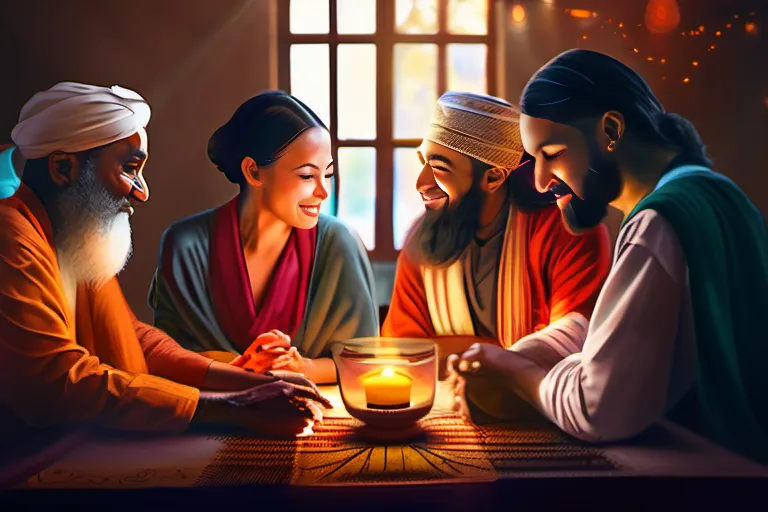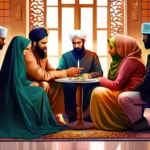Exploring the role of these three major religions in shaping modern culture and fostering interfaith dialogue
In today’s diverse world, understanding the significance of the world’s major religions is crucial. This article delves into the importance of Hinduism, Islam, and Christianity in contemporary society, highlighting their shared values, unique aspects, and the role they play in fostering interfaith dialogue.
The Historical Roots of Hinduism, Islam, and Christianity
How did Hinduism, Islam, and Christianity become intertwined with our modern world? These religions have deep historical roots that span centuries, each playing a pivotal role in shaping societies across continents.
Imagine for a moment, if you will, the tapestry of human history as a vast canvas. The threads that make up this intricate design are Hinduism, Islam, and Christianity. Each religion has its own distinct colors but together they paint a rich picture of human belief and culture.
Let’s delve into the origins of these religions. Hinduism, with its ancient scriptures like the Vedas, dates back to the 2nd millennium BCE in the Indian subcontinent. It’s like an evergreen tree, continually growing and adapting while still maintaining its roots. Islam was born around the 7th century CE, originating in the city of Mecca under Prophet Muhammad. Its expansion across the Middle East and beyond is akin to a powerful river carving through rugged terrain, leaving behind fertile lands.
Christianity emerged from Judaism in the first century CE, evolving into a global faith that spread with the zeal of early missionaries. Like the sun, it casts its light far and wide, touching every corner of the globe. These religions have faced numerous challenges throughout history—rivalries, conquests, and conversions—but they also share stories of resilience and transformation.
Consider how these religions have influenced modern culture. Think about the festivals, art, literature, and even technology that bear their marks. Are you aware that many concepts in science and philosophy can be traced back to religious ideas? For instance, the notion of a universal moral code or the pursuit of spiritual knowledge has roots in all three faiths.
But beyond their historical importance, these religions today continue to shape societies through interfaith dialogue and communal practices. They offer a bridge between different cultures and beliefs, fostering understanding and peace. How can we harness the power of shared values like compassion, justice, and love to build a better world?
The journey of Hinduism, Islam, and Christianity is not just about the past but also about their ongoing influence in today’s society. They are more than just ancient texts or cultural artifacts; they are living, breathing entities that continue to evolve and inspire generations.
In our quest to understand these religions, we uncover layers of complexity and beauty. Each belief system holds the key to unlocking deeper insights into human nature and our place in the world. As we explore their shared values and unique aspects, let us embrace this exploration as a journey that can lead to greater unity and harmony.
Shared Values and Unique Aspects
Imagine a tapestry, woven with threads from various cultures and beliefs. Each thread represents one of the world’s major religions—Hinduism, Islam, and Christianity. These three religions, while distinct in their origins and practices, share common values that bind them together in ways that are both profound and practical.
Let’s first look at Hinduism. The Sanatana Dharma, or eternal law, emphasizes the concept of dharma—ethical duties and righteousness. This belief encourages harmony with nature and the cosmos, fostering a respect for all living beings. Could this be why you often find echoes of these values in environmental movements today? It’s as if Hinduism’s teachings have seeped into our modern consciousness, guiding us towards sustainable practices.
Now turn to Islam, which is rooted in the teachings of Prophet Muhammad, emphasizing submission to the will of God. The principle of tawhid, or monotheism, and the importance of community (ummah) are central. How often do these values resurface in discussions about global unity and human rights? The emphasis on social justice and moral conduct in Islam is a powerful reminder that despite our differences, we all seek to build societies where everyone can thrive.
Lastly, let’s explore Christianity. Its roots in the teachings of Jesus Christ promote love, forgiveness, and compassion—values that have deeply influenced Western thought and society. The concept of love thy neighbor is a cornerstone of Christian ethics, prompting individuals to act altruistically towards others. Could this be why many charitable organizations find their inspiration rooted in Christian principles? It’s as if the teachings of Christ are alive and well in our contemporary world, driving us towards acts of kindness and service.
Each religion has unique aspects that set it apart—Hinduism with its intricate rituals and belief in karma; Islam with its strict ethical codes and emphasis on community; Christianity with its focus on personal faith and spiritual transformation. Yet these differences also serve to complement one another, creating a rich tapestry of beliefs and practices.
By exploring the common values and unique aspects of Hinduism, Islam, and Christianity, we gain a deeper understanding of how these religions shape modern culture and foster interfaith dialogue. These shared values remind us that despite our differences, there is much we can learn from each other, and much more we can achieve when we work together.
The Role of These Religions in Modern Culture
How do Hinduism, Islam, and Christianity shape our modern world? These religions, like rivers carving landscapes over time, subtly yet profoundly influence contemporary culture, art, politics, and social norms.
Imagine a vibrant canvas; each religion contributes its unique hues. Hinduism’s intricate tapestry of deities and philosophies weaves through the fabric of Indian society, influencing everything from daily rituals to political ideologies. The concept of dharma, or duty, permeates social interactions, guiding behavior in both public and private spheres.
Islam too leaves its indelible mark. Its principles of justice, charity, and community resonate globally, shaping not just religious practices but also ethical standards and legal frameworks in many countries. The call to prayer echoes through cities and towns, a constant reminder of the divine presence in everyday life.
Christianity, with its teachings of love and compassion, has been a driving force behind social movements for justice and human rights throughout history. From abolitionists fighting against slavery to civil rights activists seeking equality, Christian values have often been at the forefront of progressive change.
But how do these religions coexist in today’s interconnected world? They influence each other, creating a complex mosaic where ideas blend and evolve. For instance, artists draw inspiration from religious themes, blending diverse cultural expressions to create works that resonate universally. Politicians grapple with balancing traditional values with modern demands, often drawing on religious teachings for guidance.
It’s easy to see how these religions shape our world, but the real question is: Can we harness their power for positive change? By understanding and respecting each other’s beliefs, we can foster a more harmonious society. Imagine a world where differences are celebrated rather than feared – wouldn’t that be transformative?
As we navigate the complexities of modern life, let us remember that these religions offer not only spiritual guidance but also tools for building a better future. By engaging with their teachings and practices, we can create a more compassionate, just, and interconnected world.
Interfaith Dialogue: Bridging the Gap
Interfaith dialogue: Bridging the Gap
Imagine a world where religion is not a source of division but a bridge to understanding and peace. How can we achieve this utopian vision in today’s society? The answer lies in interfaith dialogue, a process that brings people from different faiths together to share their beliefs, values, and experiences. Through this conversation, we can unveil the common threads that bind us despite our differences.
Consider the diverse tapestry of humanity as a canvas, with each religion representing a vibrant thread. Without interfaith dialogue, these threads remain separated, creating a fragmented picture. But when we engage in meaningful conversations across religious lines, we can weave this fabric together into a beautiful mosaic that reflects our shared humanity.
Interfaith dialogue is not just about discussing the differences; it’s also about emphasizing the commonalities. For instance, all three religions—Hinduism, Islam, and Christianity—promote love, compassion, and social justice. By highlighting these shared values, we can foster a sense of unity that transcends religious boundaries.
Moreover, interfaith dialogue provides a platform for addressing contemporary issues such as climate change, poverty, and human rights. When religious leaders come together to discuss solutions, they bring a wealth of resources and perspectives to the table. This collaboration can lead to more effective and inclusive responses to global challenges.
In conclusion, interfaith dialogue is essential in today’s society for fostering understanding, cooperation, and peace among followers of different religions. It’s a powerful tool that helps us bridge gaps and build stronger communities. Let us embrace this dialogue with open hearts and minds, for it holds the key to a more harmonious world.
Case Studies: Successful Interfaith Initiatives
Understanding the Importance of Hinduism, Islam, and Christianity in Today’s Society
Imagine walking through the vibrant streets of any major city today. You might see people wearing saris, hijabs, and kurtas; hear prayers from mosques, temples, and churches echoing together; and observe diverse communities coming together for festivals and celebrations. These scenes are not just random happenings but a testament to the profound influence of Hinduism, Islam, and Christianity in shaping modern culture.
Each religion has its own rich history and traditions that have shaped societies across continents. Hinduism’s emphasis on dharma (duty) and karma guides millions in India and beyond, fostering a deep connection to the natural world and promoting social harmony. Islam, with its principles of justice and community service, inspires acts of charity and communal worship, bringing people together under the umbrella of shared beliefs and practices.
Christianity’s message of love, forgiveness, and compassion continues to resonate globally, influencing ethics, education, and human rights movements worldwide. These religions are not just historical artifacts but living, breathing traditions that continue to shape individual lives and collective identities today.
Their influence extends far beyond religious practices. Think about how cultural festivals like Diwali, Ramadan, and Christmas bring people of all backgrounds together, celebrating light over darkness, community, and the spirit of giving. These shared experiences highlight the common threads among religions—our quest for meaning, our search for purpose, and our desire to connect with something greater than ourselves.
Moreover, these religions often serve as bridges in a divided world. They offer a platform for interfaith dialogue, fostering mutual respect and understanding. By engaging in respectful conversations and learning from one another’s traditions, we can build stronger communities where diversity is celebrated rather than feared.
The role of Hinduism, Islam, and Christianity in today’s society is not just about belief; it’s about creating a world where everyone feels seen, heard, and valued. By understanding the significance of these religions, we open ourselves to deeper connections and a more harmonious global community. Let us embrace this journey together, one conversation at a time.
The Future of Interfaith Relations
As we look to the future, one question looms large: How can we ensure that interfaith relations continue to thrive in our increasingly diverse and interconnected world? The challenges are many, but so too are the opportunities. In a global landscape where tensions between different religious groups still exist, fostering understanding and harmony among followers of Hinduism, Islam, and Christianity is not just desirable—it’s essential.
The future of interfaith relations hinges on our ability to address these challenges head-on. One key issue is education. How do we ensure that young people from all faith backgrounds understand the values of tolerance and respect for others? We need programs that expose children early on to the richness and diversity of different religious traditions, using metaphors like planting seeds of understanding in fertile ground.
Another challenge lies in addressing the narratives that often perpetuate division. How do we counteract harmful stereotypes and prejudices? We must engage in open dialogue, allowing individuals from various faiths to share their perspectives freely without fear or judgment. This can be likened to a bridge-building exercise, where each faith tradition is a piece that needs to fit together perfectly for the structure of peace to stand strong.
Finally, it’s crucial to create platforms for cooperation and mutual aid. Whether through community service projects, joint cultural events, or shared educational initiatives, these collaborations can serve as powerful tools in breaking down barriers between communities. By working side by side on common goals, people from different faith backgrounds can see each other not just as fellow humans but as partners in a broader mission of peace and understanding.
In this ongoing journey towards interfaith harmony, let us remember that every step forward is a step towards a more united and compassionate world. How will you contribute to this future? The choices we make today shape the tomorrow we all hope for. Together, we can build a society where diversity isn’t just celebrated but cherished as the rich tapestry of our global community.
Conclusion
 By gaining a deeper understanding of these three religions, we can promote tolerance, mutual respect, and cooperation among people of different faiths. This is essential for building a more peaceful and harmonious world.
By gaining a deeper understanding of these three religions, we can promote tolerance, mutual respect, and cooperation among people of different faiths. This is essential for building a more peaceful and harmonious world.











